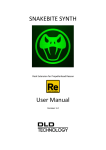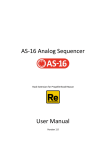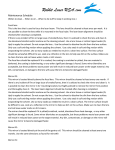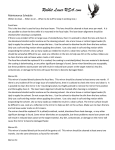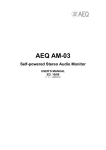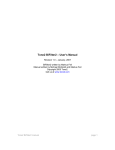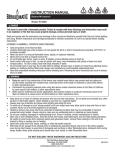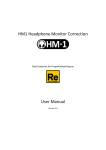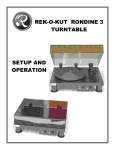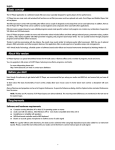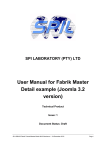Download SNAKEBITE MONO SYNTH User Manual
Transcript
SNAKEBITE MONO SYNTH Rack Extension for Propellerhead Reason User Manual Version 1.0 INTRODUCTION Snakebite is a hybrid digital analog synthesizer with the following features: Triple oscillator with variable shape and morph controls 18db highly resonant low pass filter Venom control for filter overdrive Pre-filter bitcrush for extra harmonics Bucket Brigade Device (BBD) delay Binaural sub audio bass (8-15Hz) Flexible matrix LFO / CV routing Low DSP usage DESIGN Snakebite is designed to make sounds that would not normally be possible using a traditional virtual analog (VA) synth design. It is not designed to be an everyday 'go-to' synth, rather a source of rich and unusual tones, especially in the low to mid-range. Special care has been taken to make the synth work well in the live environment, with controls such as modwheel and aftertouch automatically assigned. A simplistic matrix routing system is employed that avoids the use of complex programming. Plenty of external CV control is available, and the audio path can be broken to insert external audio or prefilter effects. ROUTING MATRIX All the lighter coloured knobs can be controlled by the internal routing matrix. Knobs are identified by their column and row, and all routing sources have two knobs to change their destination column and row. Each routing source can control one column and multiple rows at a time (so for example you could control the pitch of all 3 oscillators from a single source). LIMITATIONS Snakebite is unashamedly digital at heart – and sometimes this can be heard in aliasing noise at high frequencies. If this causes problems then just use the mixer LPF or EQ to remove it. REVISION HISTORY V1.00 Initial Version V1.01 Changed the graphics due to global outrage and panic. USAGE INSTRUCTIONS – FRONT PANEL THE OSCILLATORS There are 3 identical oscillators available with the following features: OCTAVE: Increases or decreases the pitch of the tone by up to +/- 3 octaves. SEMITONE: Increases or decreases the pitch of the tone by up to +/- 11 semitones. TUNING: Smoothly increases or decreases the pitch of the tone by up to +/- 3 semitones. This can be controlled from the routing matrix. AMPLITUDE: Changes the amplitude (volume level) of each oscillator. This can be controlled from the routing matrix. SHAPE: Each oscillator has 3 defined shapes, SINE (0%), TRIANGLE (50%) and SQUARE (100%). This knob allows you to smoothly fade between the 3 shapes and can be controlled from the routing matrix. Note that the oscillator shapes are created using sum-of-sines, so don't look quite like their expected shapes when the time domain waveform is analysed. However, in the frequency domain they have very similar tones over the audible range and reduce the problem of high frequency aliasing. MORPH: This morphs the shape so that centre cross-over point of the wave is moved backwards or forwards. It's like PWM, but works with all wave shapes. This can be controlled using the routing matrix to introduce extra harmonics in the tone. FILTER Snakebite uses an 18dB low pass filter (LPF) with pre-filter bit crush and post-filter distortion. All variables can be controlled by the routing matrix. CUTOFF: Changes the cut-off frequency of the filter. Note that the frequency is also linked to the accent and filter envelop. CRUSH: Uses a classic bit crush effect to reduce the resolution of the input signal, adding artificial digital noise and harmonics. VENOM: Increases the audio level of the signal past the design limits of the filter. This causes the filter to distort internally adding extra harmonics and grit. RESONANCE: Feeds some of the filtered signal back into the filter, causing an increase in volume around the cut-off frequency. At high values, the filter may start to self-oscillate. DISTORTION: Applies a simple digital distortion to the output signal, adding noise and harmonics. ENVELOPE GENERATORS F.ENV: Standard ADSR envelope controlling the filter cut-off. A.ENV: Standard ADSR envelope controlling the post filter signal amplitude. MOD ENV: An ADR envelope generator which acts as an input to the routing matrix: ATTACK: The rate of attack of the envelope DECAY: The rate of decay after the attack phase INTENSITY: The percentage of the envelope signal sent to the routing matrix. This may be negative RELEASE: The rate of decay once the note is released, also inversely controls the sustain level COLUMN: The destination column of the envelope signal ROW: The destination row of the envelope signal, set to 'Off' to disable EFFECTS Snakebite comes with a 4096 stage bucket brigade device (BBD) based delay with resonant anti-aliasing filter. TIME: Sets the duration of the delay – longer durations have lower bandwidth, and therefore only low tones will be delayed. Very short durations may cause unwanted audible effects. FEEDBACK: Controls how much of the signal goes into the delay circuit. Set to 0 to disable delay. ANALOG: This causes artificial errors in the oscillator tuning and BBD delay times, to make the synth sound less digital. Note that when returning this control to zero, the note must completely stop playing before all oscillators will re-sync. BINAURAL: This sets one or more oscillators into binaural sub bass mode. When in binaural mode, the synth will detune the left and right channels slightly to create a beat frequency several octaves lower in the 8-15Hz range. When listened to on headphones, a psychoacoustic effect may cause listeners to 'feel' a deep bass note. When using speakers, this effect is usually perceived as a pleasant stereo separation. Note: this effect depends on the user, listening apparatus and the note itself. Some users may find the effect nauseating or disturbing when used with headphones. Please use with care! LEVEL VOLUME: Controls the final output volume. Can be controlled from the routing matrix. ACCENT: Accent works with the mod wheel to add to the filter cut-off, filter envelope sustain and amp envelope sustain levels. Raising the accent makes the note sound brighter and louder. Whatever value this control is set to, the mod-wheel will make up the rest. So setting accent to a low value will give a lot of mod-wheel control over the sound, setting it to a high value will give minimal control. Note: Accent control can be used instead of a mod wheel when needed. CONTROL VELOCITY: Determines what the note velocity controls. This can be amplitude, filter cut-off, or both. SLIDE: Sets the note slide rate. Set to zero to disable slides between notes. LFO Snakebite has 2 built in low frequency oscillators (LFO). If your control keyboard supports after-touch, then this will be fed into LFO2 rate and intensity controls. (Set LFO2 intensity to zero, and LFO2 destination to tuning on all rows for after-touch vibrato) TYPE: Sets the wave type of the LFO. This can be Sine, Triangle, Saw, Square or Random. RATE: Sets the frequency of the LFO, from very slow to fast. INTENSITY: Sets how much LFO signal is fed into the routing matrix. COLUMN: The destination column of the LFO signal ROW: The destination row of the LFO signal, set to 'Off' to disable CV Snakebite has 3 CV inputs which can be routed to any control in the routing matrix. COLUMN: The destination column of the CV signal ROW: The destination row of the CV signal, set to 'Off' to disable Note: CV level can be controlled using the trim knobs on the back panel. USAGE INSTRUCTIONS – REAR PANEL CV INPUTS GATE / CV: The synth will respond to gate / CV inputs. Unlike most synths, it does not clamp the CV input to a valid note, so you can use this for slides or alternative pitches. CV and MIDI data can be used at the same time, the synth will use the last note received. ACCENT: Controls the Accent on the synth. This can be used with pattern sequencers to add variations. CUT-OFF / RES / DRIVE: Controls the filter cut-off, resonance and drive (venom) on the synth. CV-1 / CV-2 / CV-3 External inputs that can be used to control most parts of the synth via the routing matrix. BREAKOUTS It is possible to insert extra effects into the signal path before the filter section. To do this, connect an effect between the out and in sockets. You can also process external audio by connecting to the in sockets – at this point the oscillators audio will be detached. A valid note must be played on the synth via MIDI or CV otherwise the filter and envelopes will be off. OUT LEFT / OUT RIGHT: The summed outputs of the 3 oscillators (before the filter or envelopes). The sound will continue playing after note off. IN LEFT / IN RIGHT: This audio is fed into the filter section. Connecting to these sockets will break the link between oscillators and filter. GATE OUT: A CV signal that is high when Snakebite is playing a note. This can be used to trigger external effects, LFO or envelope generators. DISTORT AND DELAY CRUSH: CV input to control the pre-filter bit crush effect. DISTORT: CV input to control the post-filter distortion effect. TIME: CV input to control the delay time. FEEDBACK: CV input to control the delay feedback. OUTPUTS LEFT / RIGHT: The main stereo audio outputs. These will normally auto connect to your mixer. FUSE In the event of malfunction, unscrew and replace with suitable 10 amp fuse. HEALTH WARNING CREDITS Design and coding by Richard Harvie, DLD Technology Ltd – http://www.dldtechnology.com Graphics by Steven James, Chimera Creations - http://www.chimeracreations.co.uk Patches by: Jaun Pablo (synclab) William Noise Bleed Matt Hammond Simon Balder Okeh Lab – Subvert Edsoul Sterio Evo Richard Harvie Thanks to all that have helped test Snakebite and made it what it is!










